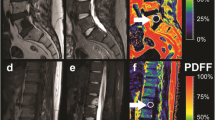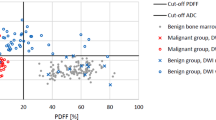Abstract.
Our objective was to evaluate the possible role of opposed-phase gradient-echo (GRE) sequence in predicting the nature of vertebral lesions supposing that in the case of malignancy fat is completely replaced while in the case of benign lesion fat is still present. Eighty-six patients with vertebral lesions underwent MR examination at 0.5 T. The MR protocol included a T1-weighted spin-echo (SE) and an opposed-phase GRE using the same parameters (TR=280–320 ms, flip angle=90°, slice thickness=3.5–4 mm, matrix=256×160–192, field of view=34–36 cm, no. of excitations=2–4) except for TE (10 ms in SE vs 7 ms in GRE) to obtain opposed-phased images. Qualitative (nature of lesion, detectability, degree of signal intensity (SI), marrow pattern) and quantitative (SI on opposed-phase GRE minus SI on T1-weighted SE minus SI ratio=SI on out-of-phase GRE images divided by SI on T1-weighted SE images) analysis were performed. The SI ratio values were analysed using Mann-Whitney rank-sum test and receiver operating characteristics (ROC) curve. Lesions resulted to be malignant in 45 and benign in 41 patients (23 biopsies, 20 MR follow-ups, 43 clinical and other imaging follow-ups). Based on visual inspection of opposed-phased images, visual SI was evaluated high in 38 (34 malignant, 34 benign), mild in 28 (9 malignant, 19 benign) and low in 20 (2 malignant, 18 benign) patients. Based on region-of-interest measurements, SI ratio values range was 0.36–6.2 (mean value=1.68+/–0.82) for malignant and 0.07–1.54 (mean value=0.77+/–0.44) for benign lesions. A cut-off value of 1.2 gave a sensitivity, specificity, accuracy, negative predictive value and positive predictive value, respectively, of 88.8, 80.49, 84.88, 86.4 and 83.33%. The ROC analysis of the SI ratio showed an area under ROC curve of 0.92 and a statistically significant difference between the two groups of lesions was observed (p<0.01). The GRE opposed-phase sequence can help to predict the nature of a vertebral lesion. This fast and widely available technique together with morphological criteria can improve the accuracy of MRI.
Similar content being viewed by others

Author information
Authors and Affiliations
Additional information
Electronic Publication
Rights and permissions
About this article
Cite this article
Zampa, V., Cosottini, M., Michelassi, M. et al. Value of opposed-phase gradient-echo technique in distinguishing between benign and malignant vertebral lesions. Eur Radiol 12, 1811–1818 (2002). https://doi.org/10.1007/s00330-001-1229-6
Received:
Revised:
Accepted:
Published:
Issue Date:
DOI: https://doi.org/10.1007/s00330-001-1229-6



